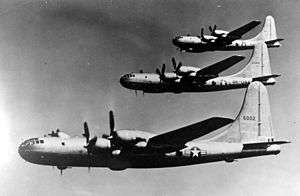1950 Rivière-du-Loup B-50 nuclear weapon loss incident
|
Three B-50A bombers in formation; similar to the B-50 that dropped the bomb at Rivière-du-Loup | |
| Incident summary | |
|---|---|
| Date | November 10, 1950 |
| Site |
Rivière-du-Loup, approx 300 mi (480 km; 260 nmi) northeast of Montreal, Quebec, Canada 47°56′6″N 69°25′15″W / 47.93500°N 69.42083°WCoordinates: 47°56′6″N 69°25′15″W / 47.93500°N 69.42083°W |
| Fatalities | 0 |
| Injuries (non-fatal) | 0 |
| Aircraft type | Boeing B-50 Superfortress |
| Operator | United States Air Force |
| Flight origin | CFB Goose Bay |
| Destination | Davis–Monthan Air Force Base (instead diverted to an Air Force base in Maine) |
The 1950 Rivière-du-Loup B-50 nuclear weapon loss incident refers to loss of a nuclear weapon near Rivière-du-Loup, Quebec, Canada, during the fall of 1950. The bomb was released due to engine troubles, and then was destroyed in a non-nuclear detonation before it hit the ground.
Background
Returning one of several US Mark 4 nuclear bombs secretly deployed in Canada, a USAF Boeing B-50 Superfortress had engine trouble and jettisoned the weapon at 10,500 feet (3,200 m). The crew set the bomb to self-destruct at 2,500 ft (760 m), and released it over the St. Lawrence River. The non-nuclear explosion shook area residents and scattered nearly 100 pounds (45 kg) of moderately radioactive uranium (U-238) used in the weapon's tamper. The plutonium core ("pit"), which is the key component for a nuclear reaction and detonation, was not installed in the bomb at the time. The absence of the core probably was due to their cost and relative scarcity at the time.[1]:93[2] Standard US Air Force protocol prohibited any aircraft carrying a nuclear device to land with the device if the aircraft was experiencing engine problems. It had to be jettisoned. The plutonium trigger was always removed prior to flight and shipped separately to prevent accidental nuclear activation. This also was standard protocol. At the time of the incident, the aircraft was returning from CFB Goose Bay to Davis–Monthan Air Force Base. The troubled aircraft successfully landed at an Air Force Base in Maine.[1]
The incident was immediately covered up at the time, and explained away as 500-pound (230 kg) military practice bombs being detonated. It was not until the 1980s that the Air Force confirmed it was a nuclear incident.[1]:94–95
See also
References
- 1 2 3 Septer, Dirk (2012). Lost Nuke: The Last Flight of Bomber 075. Victoria, BC: Heritage House. ISBN 1926936868.
- ↑ Norris, Robert S.; Arkin, William M.; Burr, William (1999). "Where they were" (PDF). Bulletin of the Atomic Scientists. 55 (6): 26–35. doi:10.2968/055006011.
